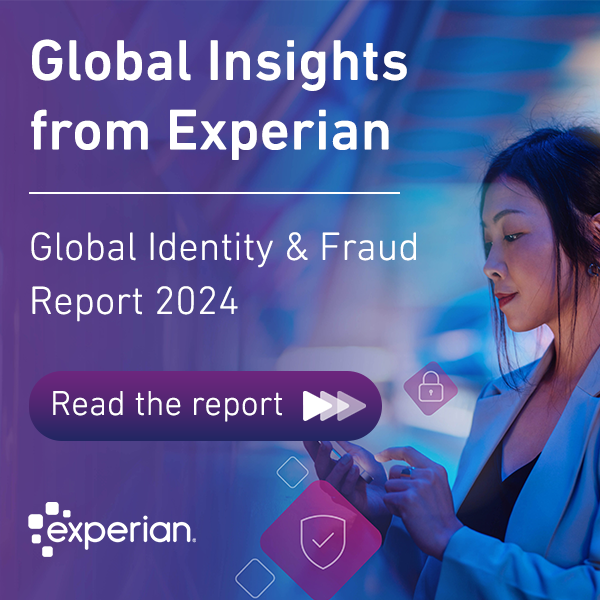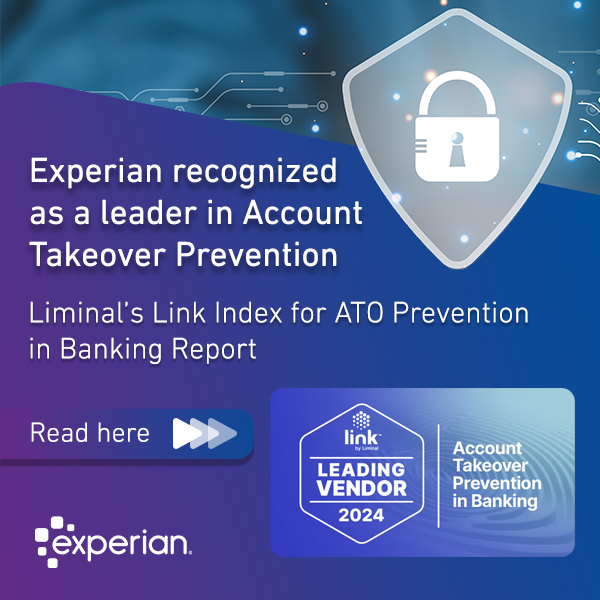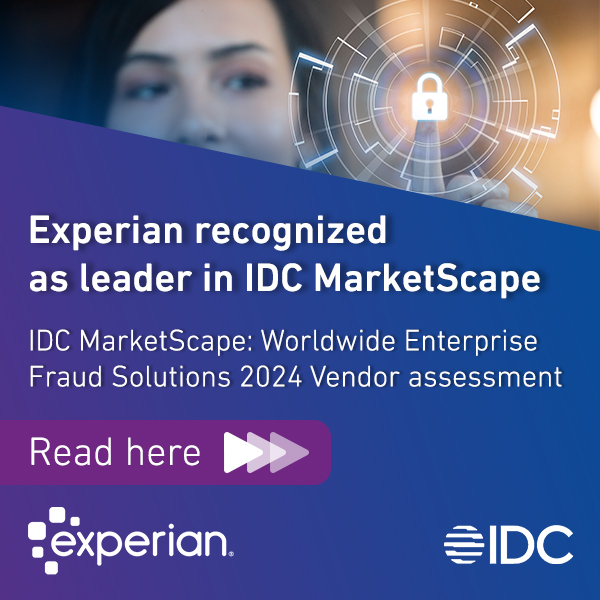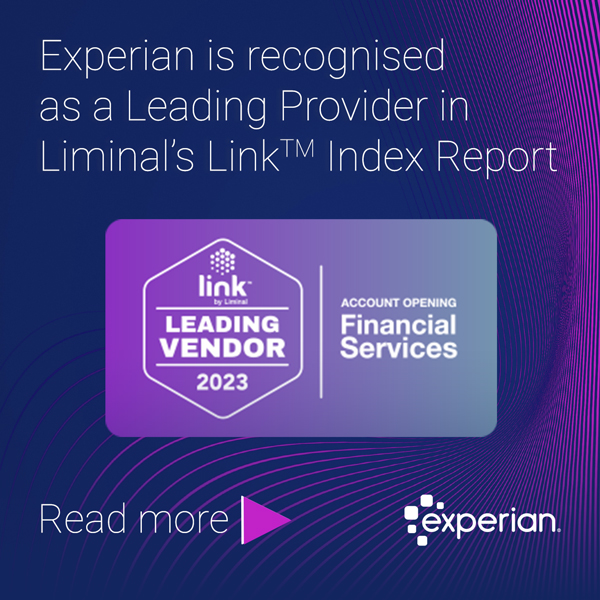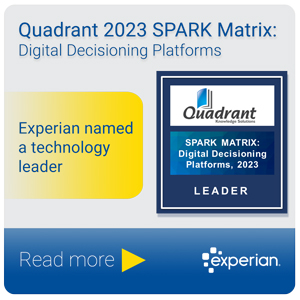All posts by Managing Editor, Experian Software Solutions

Experian’s latest research shows that the crisis of the past few years has yielded a new, savvier digital consumer. With the rapid move to online services amidst the pandemic, consumers worldwide adapted—and quickly. Fifty-three per cent of consumers say they have increased their online spending and transactions within the past three months, and 50% plan to increase it even more over the next few months. As online activity has surged, so too have consumer expectations for friction-free, secure transactions. More than 80% of consumers say a positive online experience makes them think more highly of the brand. And if businesses don't meet those expectations? Well, switching providers is only becoming easier . For financial service providers, the evolution of consumer behaviour presents both an opportunity and a challenge. It's never been more critical to ensure that digital experiences are convenient and frictionless. However, soon that will be the expectation and not the draw for new customers. Instead, finding unique ways to compete will be what separates the good from the great. Convenience versus risk In our latest survey, consumers ranked security, convenience, and ease of recognition as the top contributors to a positive online experience. All of these are vital components to providing a frictionless transaction. However, seamlessly logging in to a financial app, applying for credit, or managing a balance isn't yet the standard for every provider. Many traditional banks continue to play catch-up with digital upstarts, but consumers are becoming less tolerant of barriers to accessing services and products, with 23% saying that businesses aren’t meeting their expectations for digital experiences. This provides businesses with the opportunity to attract and retain new customers, especially those tired of manual account onboarding processes. For instance, leveraging emerging recognition tools adds to the convenience factor, limiting the time customers spend inputting data and streamlining the entire experience. But even as they continue to prioritise frictionless processes, businesses should be wary of sacrificing security or increasing their own risk. In our survey, 73% of consumers said that the onus is on businesses to protect them online. While they don't want security efforts that slow down their transactions, they expect the level of security to remain high nonetheless. On the business side, we've also seen providers creating friction-free options for lending—for example, in the Buy Now, Pay Later (BNPL) space—that enable consumers to access credit nearly immediately. But even with the convenience, there is still a need to manage affordability and ensure that these customers aren't introducing additional risk to credit models. Differentiate to retain customers: The growing role of rewards With all the innovation underway, a friction-free experience will become the standard. And it may already be so among digital-first businesses. This begs the question: If a secure, convenient experience is the norm for consumers, then how can businesses differentiate themselves? The next competitive differentiator will be how businesses reward customers for their loyalty. It's no longer enough to provide new customers with low-interest or no-interest credit on small purchases. Forward-looking financial services providers are getting far more creative with their rewards. For instance, businesses offering BNPL are enabling their customers to accumulate loyalty points for using the service with multiple retailers. Customers can then put those points to use as discounts on merchandise from the places they already love to shop. Data sharing and analytics play a significant role in this approach, allowing businesses to understand their customers' behaviours and personalise offers and rewards. Notably, our survey reveals that 83% of consumers say their awareness of how companies use their personal data for security, convenience, and personalisation has increased. Today's consumers are as digital as ever, and there's no going back. While friction-free may have been the differentiator before, it's rapidly becoming the standard. Going forward, financial services providers will need to find a new way to compete for savvy consumers who expect—and demand—secure, frictionless online experiences. Stay in the know with our latest research and insights:

Did you miss these April business headlines? We’ve compiled the top global news stories that you need to stay in-the-know on the latest hot topics and insights from our experts. Experian Named Top Provider of Digital Identity Juniper Research acknowledges Experian as an established leader in digital identity in its competitor leaderboard, highlighting the flagship identity and fraud platform, CrossCore™. The report also looks at the key areas of digital identity and where its headed. What’s the hardest part about using synthetic data correctly? Braintrust, Protocol's experts on the biggest questions in tech, talks to Eric Haller, VP and General Manager of Identity and Fraud and Datalabs, about using synthetic data and what challenges are involved in the process. Passwordless MFA: The Single Way To Mitigate the Top 5 Threats to Your Customer Identities As cyber criminals discover new methods to compromise consumer accounts, forward-thinking organizations are adopting solutions for better security and a smoother customer experience. Experian Finds Mobile Wallets Rival Traditional Payment Methods The new Experian Global Insights Report concludes that digital online spending will continue to gain strength even as consumers emerge from lockdown and return to in-person transactions. 6 e-commerce cyber fraud challenges in 2022 Mike Gross, VP Applied Fraud Research and Analytics, discusses the biggest cyber fraud trends predicted to come up in 2022. From deepfake fraud to fraud as a service, and the developing relationship between digital identity and verification with fraud detection. Stay in the know with our latest research and insights:

We surveyed 6,000 consumers and 2,000 businesses from 20 countries worldwide as part of our ongoing efforts to learn more about how, why, and where consumers interact with businesses online.

The evolving expectations and experience of the new digital consumer The expectations of consumers are changing rapidly. People of all ages and incomes are online, seeking the right products and services to manage their financial lives digitally in a secure, speedy, and frictionless environment. A look inside: Our latest research reveals the rise of a new digitally savvy consumer—one who is increasingly aware of new payment methods, advanced recognition tools, and the use of AI, and has higher expectations of their digital experience. Read the report to find out what businesses can do to harness the digital opportunity: 1. Leveraging the AI advantage 2. Incorporating embedded finance 3. Introducing new, more secure technologies 4. Educating consumers about how you use their data 5. Exploring solutions that aggregate emerging technologies Online spending is continuing its upward trend, with 53% of consumers surveyed saying they have increased online spending and transactions in the past three months, and 50% predicting that their spending will increase in the next three months. Enabling this shift is the extent to which businesses can provide a quality digital experience. 81% of consumers said that a positive online experience, which includes interactions with multiple digital touchpoints makes them think more highly of a brand. Consumers simply do not tolerate poor-quality online experiences and will take their loyalty to businesses that can meet their expectations. Speed and security are a driving force for consumers in the payments space, which is reflected in rapid rise in mobile wallet payments. Rivalling traditional payment methods, 62% of consumers say they’ve used a mobile wallet in the last six months. Consumers are embracing these new habits across the board, with 18% saying they have used BNPL in the past six months, and 71% seeing it as secure. With the rise and increasing awareness of new payment methods like BNPL, consumers who have lacked access to traditional banking, lending and credit cards now have additional financial options, giving businesses the opportunity to prioritise financial inclusion. The rise of new and increased online activity has resulted in increased concerns about online security, with 42% of consumers more concerned than they were 12 months ago. With this awareness comes opportunity for businesses to leverage new recognition approaches. Biometrics seems to resonate with consumers, with 81% reporting that they feel most secure when encountering physical biometrics. Trust and security are becoming interdependent, with consumers expecting strong security measures from businesses. 73% of consumers say that the onus is on businesses to protect them online, and 45% identify the belief that businesses have strong security measures in place as the top reason to trust an online transaction. As consumers become ever-more educated and aware of the digital world, they want businesses to communicate with them about why they are using personal data. 63% of consumers are willing to share their data and see it as beneficial to them if they see security and convenience in return. We surveyed 6,000 consumers and 2,000 businesses from 20 countries worldwide as part of our ongoing efforts to learn more about how, why, and where consumers interact with businesses online. Read the full report Stay in the know with our latest research and insights:

According to our latest research, 53% of consumers surveyed said their online spending and transactions increased in the past three months, and this is set to continue. Online shopping has become the norm for many, but what does that mean for online fraud? As with any growing industry, the fraud associated with it is also growing and changing. We take a look at brushing scams and what businesses can do to get ahead of this type of criminal activity. What is a brushing scam? A little-known scam called brushing has increased in popularity across the globe as more consumers are purchasing online exclusively. An increase in eCommerce means consumers are relying on the reviews of previous customers when deciding what to buy or whom to buy from, increasing the number of reviews, including negative reviews that impact these businesses. Most online retailers or eCommerce sites have a rating system in which verified buyers can rate the product purchased or, in the case of third-party retailers, can rate the sellers. The better the rating, the higher the seller is listed in searches. Many of the ratings include the number of purchases in the rating factor. The more purchases, the higher the rating. A brushing scam is when someone is hired to write a favorable review for an online seller. To become a verified buyer, they order small-value items with lower shipping costs so that the cost to complete is meager. They purchase the item under someone else's name and address to become and then create a favorable review for the seller. When done multiple times, it brings up the seller's rating by increasing the number of items sold and the number of favorable ratings and then increases the chances that real buyers will purchase from the seller. Other variations of a brushing scam include sending items that were not ordered at all or even empty boxes and envelopes. The orders are used to boost third-party rating positions, which allow these sellers to be listed higher in the third-party search algorithm and ultimately placed their business/product in front of other customers wanting to buy that product. The implications of brushing scams on consumers and businesses This type of fraud is two-fold for the consumer. It leaves many victims confused because it doesn't feel like fraud, and the victims don't understand how it impacts shopping habits, which leads to little or no detection. On the surface, the scam seems harmless. However, at minimum, the receiver has had their name and address compromised and may have additional personally identifiable information compromised. As a result, additional fraud activity may occur with the stolen personally identifiable information. But it also has economic side effects. By fraudulently increasing the sales numbers on financial statements it effectively feeds false information on publicly traded company performance. In addition, the Federal Trade Commission, which protects consumers from any false marketing, sees fake reviews as a form of fraud to the consumer. Online third-party resellers have policies that prohibit sending unsolicited packages and false reviews. They will suspend or remove accounts found to be doing this activity and work with law enforcement when needed. The problem is that the third-party reseller often doesn't know when it is happening, and many brushing scams go on unreported. What businesses should do to prevent brushing scams Businesses at risk of brushing scams, such as third-party resellers, should have a risk strategy that proactively searches for suspicious brushing activity. As with any fraud type, there is no one-size-fits-all solution and should include a layered approach that will detect the various known traits of how the fraud is carried out. Below are solution types to consider in a company's risk strategy. Device Intelligence Multiple orders/reviews are done from the same device with this trend. Using device intelligence to detect when the same device is used for multiple consumers of no relation can be an effective tool in identifying this type of scam. Email Intelligence Many fake user accounts are created with an email address that does not belong to the real person. Email intelligence solutions that can confirm the legitimacy of the email associated with the consumer can be another effective tool. Biometric Intelligence Detecting fraudsters from genuine users whether the interaction is human or automated, including bots, malware, or remote access tool by using the behavioral biometrics mouse movements, typing cadence, etc. Biometric intelligence is a proven tool in increasing the number of fraud transactions caught. Link Analysis A tool that detects additional accounts with the same details as accounts with confirmed fraud that may not have been alerted with another solution. While this is a hindsight tool, it can assist in uncovering trends. Machine Learning As this scam is evolving, the use of machine learning to detect the new patterns will be a highly effective tool for the large third-party resellers to detect emerging trends and keep operational costs reasonable, quickly and effectively. Machine learning is highly effective in reducing customer friction. As with any risk strategy, people within the organization should be made aware of the scam type and the internal reporting process. All customer reports should be taken seriously and reported to the proper investigation team. Stay in the know with our latest research and insights:

Did you miss these March business headlines? We’ve compiled the top global news stories that you need to stay in-the-know on the latest hot topics and insights from our experts. Experian partners with Black Opal to bring credit options to US immigrants PYMNTS.com covers the partnership between Experian and Black Opal to boost consumer credit access to immigrants in the US. Using Crosscore and PowerCurve, Block Opal will be able to make real-time credit decisions while also managing using the platform’s tools to better manage identity verification and fraud prevention. Fraud shifting as online activity increases In this CUNA article, Brock Fritz explores Experian's Future of Fraud Index for 2022, with Experian's Chief Innovation Officer, Kathleen Peters, offering up solutions for businesses looking to mitigate the effects of more online fraud. How AI is modernizing online transactions Donna DePasquale, EVP of Global Decisioning Software, writes in Dataversity about the importance of automation and insights as objectives driving modernization through AI for businesses, and what they should focus on in order to increase customer acquisition. Online payment fraud Online payment fraud will reach 206 Billion by 2025. David Britton, Experian VP Industry Solutions Global Identity and Fraud is interviewed by David Cogan, host of the Heroes Show and founder of Eliances entrepreneur community. Stay in the know with our latest research and insights:

Juniper Research’s latest digital identity leader board predicts a big shift in the market – identity and fraud are now becoming synonymous. Experian’s position as number one vendor on Juniper Research’s leader board demonstrates why Experian’s flagship digital identity and fraud platform, Crosscore, is central to the future of identity and fraud management. “We’re thrilled Juniper has positioned us as the top provider of digital identity,” said David Britton, Vice President of Global Strategy for Digital Identity & Fraud at Experian. “Being able to accurately identify a customer in a digital transaction helps our clients provide a better customer experience and prevent fraud. Fighting fraud and reducing risk, while enabling great consumer experience is at the heart of Experian’s mission to make the digital world a safer place, even as cybersecurity rises as a worldwide threat.” Digital identity’s convergence of identity verification and fraud detection presents both opportunities and challenges for businesses, all in direct response to new consumer demands for a seamless, safe and uninterrupted digital customer journey. Key digital identity market Takeaways – Juniper Research Identity and Fraud Are Becoming Synonymous Trust is not a transactional feature of a digital identity system between identity creators and identity subjects, but rather, it is an inbuilt part. Given the unprecedented impact of the COVID-19 pandemic on eCommerce volumes, the advent of remote/hybrid working and the demand for eGovernment services, digital identity’s tie with privacy and security has become much more visible. An ever-increasing number of fraudulent activities highlights the need to ensure customer security and protection of personal and businesses data for integrity of digital identity systems. Fraud and digital identities are closely intertwined, also because preventing fraud involves getting the right identity datapoints, understanding their significance and acting upon the related findings. Governments Will Ramp Up Their Digital Identity Efforts Government regulations and initiatives around digital identity are a vital force shaping the market landscape. Success of eGovernment services is largely dependent on a mechanism of identifying citizens/users in an assured manner, usually via striving to create trusted identities. Even prior to COVID-19, governments around the globe were employing digital identity-related initiatives in areas other than eGovernment services, such as border controls and telehealth. Compelled by the challenges faced in terms of cybersecurity and citizen trust in identity initiatives, governments will increasingly collaborate with third-party vendors to come up with solutions with better usability and security. Identity Verification Use Cases and Underlying Technologies Will Continue to Dominate the Market Verification is one of the key areas affecting the digital identity market, mostly owing to the catalyst power of the pandemic digitalising transactions across all industries and business verticals. The solutions and use cases of digital identity verification (ie, login, anti-fraud, and decentralised identity) are numerous, as secure and convenient customer onboarding has been at the forefront of any critical digital engagement. These use cases and underlying technologies, such as biometrics, lend themselves to different industries and verticals and so, they will continue to enjoy customer uptake for the foreseeable future. Read now: Juniper Research Digital Identity Competitor Leaderboard Related content: Defining digital identity on the back of the ‘big digital shift’ What is digital identity and why should we care? Stay in the know with our latest research and insights:

The ecosystem of credit lending platforms and technologies has rapidly grown in the past year. Lenders now find themselves in an increasingly competitive market with new players emerging on the scene. More companies now have access to advanced analytics and automation capabilities, and this is helping businesses improve the accuracy and inclusivity of consumer lending decisions – a giant step toward achieving their growth ambitions. Our recent research shows that one of the top priorities for businesses has been to invest in new artificial intelligence and machine learning models for smarter customer decisions. But how effective is building new AI models without considering the data? What is data-centric AI? Building AI models on fixed data has already become an outdated approach. But by coupling data with the best model, better outcomes can be achieved. The concept of data-centric AI was coined by leading thinker in the AI space, Andrew Ng. Ng believed that models in production are only as good as the point-in-time data used to build them. As businesses continue to receive new data, this data needs to feed back into the model if it’s going to continue delivering the best results. This continuous loop of enriching the model with new data can be applied across use cases. The value of data-centric AI models for acquiring new customers By using the latest available data, rather than from 6-12 months ago or longer when the model was originally developed, data-centric AI models can: • More rapidly account for changes in the economy and consumer finances • Reach under-represented populations and provide greater access to credit • Take advantage of newly available types of information from data providers The value of data-centric AI in existing frameworks More observations AI is often limited by the data that was used to create the model. By using a more fluid open-source alternative, different data sets can be inputted to get more observations based on different characteristics and findings. For example, if a business wants to acquire a new type of customer, traditional AI would require a new model with new data sets to be in order to target this new customer. With data-centric AI, businesses can use an existing model and simply expand the data, thus allowing the model to work far more efficiently and target a new consumer base. It is a shared view that businesses should not build models with just their own data, because those data sources are too limited. At the very least, businesses want to combine data with a peer sample. However, an even better way is to use hybrid data sets in order to get the most observations. Data-centric AI makes that process easy without the need to create different models to see different outcomes. Up-to-date data The world is in a state of flux—populations change, people change. This means that the data pools AI models draw on may be compromised, no longer relevant, or have new meaning over time. It’s important to keep AI data sets recent and up to date, and not assume that the models used two years ago still apply today. For AI models to operate efficiently they need current, relevant data. Having a data-centric approach and sweeping through collected observations is essential for any business relying on their AI solutions. Businesses must have processes to understand and test their data to be sure the values are still adding up to what they should be. Being disciplined about data hygiene, all the way back to the source, is a necessity. Enriched and expanded data With model-centric AI, businesses are limited by the data they start with. Data-centric AI makes it possible to expand on the current customer base, which already includes data on customer attributes, with new potential customers that might mimic characteristics of a business's current base. Expanded data can also play a role with financial inclusion and credit worthiness. Having a low credit score does not necessarily mean the consumer is a bad risk or that they shouldn't be allowed access to credit—sometimes, it could mean there is simply a lack of data. Expanding data to include varied sources and adding it to current models without changing their structure, enables businesses to provide credit for individuals who may not have originally been accepted. This new approach in AI is creating solutions that are far more inclusive than previously possible. Data has massively expanded and is constantly evolving. By using data combined with advanced analytics, such as AI, there will be more sophistication in the observations that come from the data. This will allow businesses to better decide what data they choose to rely on while ensuring accuracy. By using expanded data sources, the outcomes of models are changed, leading to more inclusive models better fit for decision making and improving performance. "Models in production are only as good as the point-in-time data used to build them." Andrew Ng Infographic: Why data-centric AI leads to more accurate and inclusive decisions Stay in the know with our latest research and insights:

Global fraud predictions for 2022, plus a closer look at regional fraud trends. Stay in the know with our latest research and insights:

During the week of International Womens' Day, we shine a spotlight on the women thought leaders across Global Decision Analytics. In this Every Woman Forum, Tech Hub article, Angela Beteta Quesada, Principal DevOps Engineer, Global Decision Analytics, discusses the importance of relatable role models for women in the tech industry and how making the right choices in where and how you work can open up a wealth of different people to learn from. "As a role model I think I am relatable; I like to take risks and opportunities that are a challenge to me — and that I think are going to be good fun. That is how my whole career has developed. I also work well with people and have good communication skills — when I was a junior Java engineer, my mantra was ‘leave it with me’. I think my managers saw that they could throw things at me and have confidence that there was going to be a good result, which is a mindset I still have." Read the article to find out: How important were relatable role models at the start of your tech career? What makes an effective role model, and why? What do you feel young women at the beginning of their career can see in you that will be useful to take with them in their career? How important is it to see more role models combining the realities of motherhood and a high-pressure career? What advice would you give to a young woman starting her career in tech? Do you still look for role models in your own career? Stay in the know with our latest research and insights:

During the week of International Womens' Day, we shine a spotlight on the women thought leaders across Global Decision Analytics. In this Juniper Research interview, Kathleen Maley, VP of Analytics Product Management talks about the current state of data analytics, with the backdrop of Juniper Research's Future of Digital Awards and its recognition of AIS. Watch the video to discover: Current problems with data analytics Broad nature of activities of what is now defined as analytics Model development, model scoring, model regulatory control, model risk management and model deployment Where is data coming from - is it clean and do we understand it? Importance of humans in the development of algorithms Lack of data - where do we need to close gaps? How does looking at the past help with looking to the future - the importance of current/real-time data The expense of maintenance - tech stack - there are now alternatives Democratization of data - expanding credit access by using non-traditional sources of data Talent shortage of data scientists - low-code and no-code Extracting data value for businesses when data is ever-expanding Stay in the know with our latest research and insights:

Did you miss these February business headlines? We’ve compiled the top global news stories that you need to stay in-the-know on the latest hot topics and insights from our experts. Credit card fraud jumps to a five-year high The Mail Online covers why, according to Experian, cold-calling, text scams and crypto fraud will rise in 2022, while also pointing to a rise in fraudulent credit card applications, particularly during the busy Christmas period. The future of fraud: How digital dependency creates infinite opportunity for scammers In this Forbes article, David Armano writes about the futuristic nature of Experian's Future of Fraud Forecast for 2022, and why digital transformation has created new opportunities across the fraud landscape. Your digital impression is your first impression, here's how to make it count Inc.com looks at why your digital first impression is the new first impression, and what you can do about it. Read about the four areas to focus on to put your best foot forward digitally in 2022. The markets, Ukraine, cyberthreats, and supply risks In this episode of The Tape podcast, David Britton, Global Strategy for Identity & Fraud at Experian, talks about internet fraud and how it affects consumers and businesses. Fraud suspicions have a record high in 2021 in Brazil, says Serasa Last year Brazil had 4.1 million transactions suspected of fraud, according to the Serasa Experian Fraud Index. Read about what type of fraud threats are included, and what 2022 might look like across the fraud landscape. Stay in the know with our latest research and insights:
